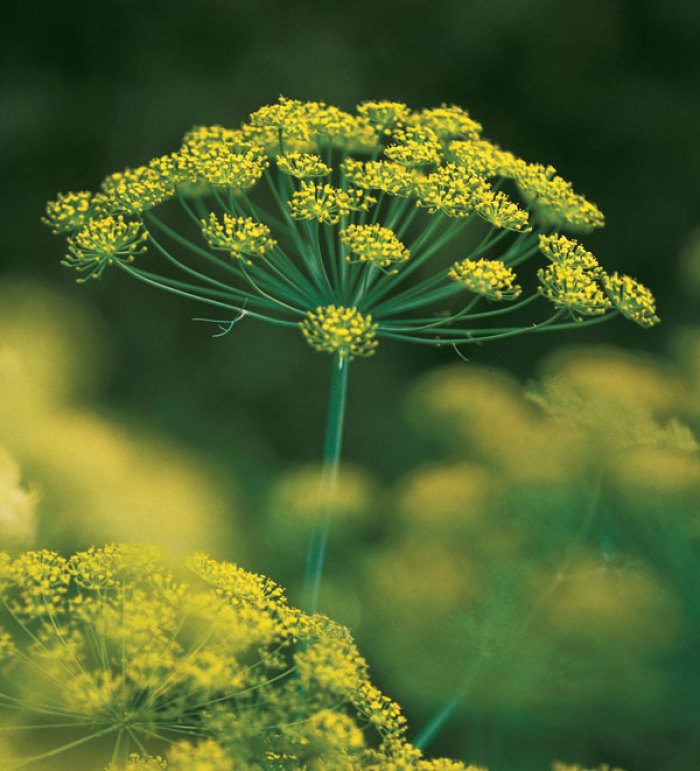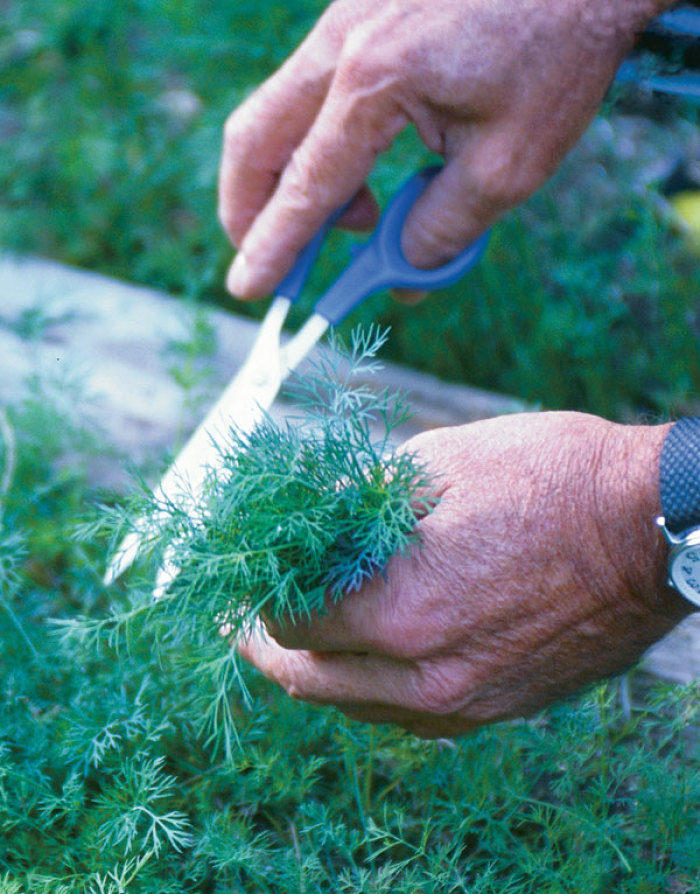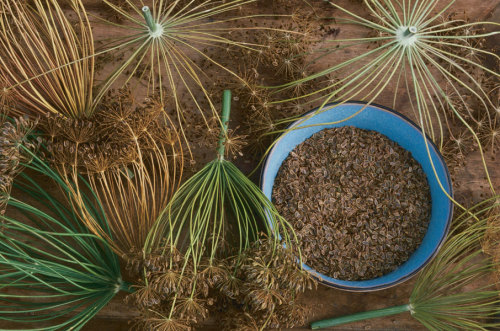How to Grow Dill
Given the right conditions, this herb will fill your summer with flavor

Many years ago, in my native England, I was exploring the tangled and sadly overgrown walled garden of an old manor house when I brushed against some self-sown dill. I knew what it was, but I had never before seen it growing. I picked some fresh leaves and then returned a few weeks later to gather some seeds. I have grown dill almost every year since. To this day, dill’s wonderfully relaxing and reassuring aroma brings back a vivid memory of that Essex countryside and the softly faded beauty that was all around me. Dill leaf and dill seed work magic in the kitchen, and I love the plant’s blue-green, ferny mist. To me, dill epitomizes the joy and lushness of a summer garden.
Dill delivers leaves quickly
Given the right conditions—and the range is broad—dill grows fast. If seed, soil, and sun are on your side, you can snip mature leaves eight weeks after planting. Because I am so eager every year to taste and smell the first dill, I generally start a few dozen seedlings indoors.
This habit is almost entirely self-serving, since the direct-seeded plants mature only slightly, if at all, behind my carefully cosseted indoor seedlings. Dill puts down a slender taproot that resents being moved, and I suspect tiny root hairs get jostled and broken in transplanting. That small setback allows the undisturbed direct-seeded competition to catch up. Succession plantings three weeks apart guarantee an unbroken supply, and its fast growth allows dill to be raised from Zones 3 through 10.

Dill is a light feeder, but it does best in reasonably fertile, open soil with full sun. Southern gardeners can even grow it in partial shade. My kitchen garden gets a top dressing of an inch or two of compost and rotted manure every year. Unless your soil lacks nutrients, dill won’t require any supplemental feeding. But to maintain the general fertility of the soil, I run weak manure tea into my drip irrigation lines every two or three weeks. And after a heavy harvest of dill, you will find that a quick shot of manure tea helps the plants recover.
Good drainage is essential, and my sandy loam (I now live on Long Island, New York) has that advantage. Heavier clay soil should be amended with lots of compost. I loosen my dill beds with deep thrusts of a spading fork to ease the passage of those slender taproots.
Most vegetables—particularly cabbage and other cole crops, onions, and lettuce—enjoy the company of dill. Carrots, however, will grow poorly if they mix with a certain chemical in dill seeds. So it’s best to keep carrots and dill far apart if you plan to let your dill self-seed.
Like other members of the Umbelliferae famil, dill forms flowers in a graceful umbrella shape. Getting through the stiff language and odd spellings in the 1597 book The Herball, or General Historie of Plantes was hard, but when I found author John Gerard’s listing of dill I felt repaid. Gerard mentions little yellow flowers “standing in a spokie tuft or rundle.”
Fastidious planting is worth the effort

After preparation of the seedbed, I form a groove by lightly pressing down with the edge of a square stick. Rows should be 6 in. apart for leaf dill and 1 ft. for seed, because the plants can get quite large when fully mature.
Dill seeds are fairly small, and they tend to clump together, so I mix them with a little dry sand; this separates them and makes it easier to get a thin, even distribution of seeds along the row. The seeds should be covered lightly with ¼ in. to ½ in. of sifted soil, then firmed and watered in. Germination takes about 10 days. You may want to thin plants to 2 in. to 6 in. apart, depending on soil fertility.
For all this pedantic care, I must confess I have had equally good results in the rich soil of my market garden using an Earthway seeder to sow unthinned 100-ft.-long rows that are 6 in. apart. But like most gardeners, I suspect, the pleasure I get from gentling the seeds into the soil of my home kitchen garden is its own reward.
Germination requires an uninterrupted supply of moisture. Long an advocate of drip irrigation, I lay strips of drip hose about a foot apart. The emitters are also a foot apart; in my soil, this gives adequate coverage. Drip irrigation puts water where the plants need it—at their roots. Overhead watering creates a perfect environment for fungus and mildew diseases.

Dill is too fast for pests to catch
Grown for its leaves, dill is usually in and out of the garden before it can attract pests. If the plant matures to the seed stage, it can be afflicted, although rarely, with tomato hornworm, aphids, or even carrot rust fly. Hornworms are big enough to be handpicked, although their camouflage makes them hard to find until your eyes get used to spotting their bulk amid the delicate ferny leaves of the dill.
Aphids are best dealt with by snipping off the affected plant, spritzing away the aphids with a spray of water, and enjoying the dill yourself. I believe that larvae of the carrot rust fly attack dill only when it is grown where carrots were grown before it. Parasitic nematodes are the best remedy.
One size dill may not fit all
Seed catalogs offer a choice of dill varieties. ‘Bouquet’ has long been a favorite of commercial growers for both leaf and seed production, although many homes and market gardeners prefer ‘Dukat’, sometimes listed as ‘Tetra’ dill, for its abundant and sweet foliage.
In 1997, Johnny’s Selected Seeds introduced ‘Superdukat’, a variety the catalog said has more essential oil than ‘Dukat’ and grows straighter and more uniformly for easier harvesting. It also germinated sooner and grew faster than the other four varieties in my garden.
‘Long Island’ or ‘Mammoth’ dill, different names for the same plant, is also favored by commercial growers as a reliable producer. The ‘Fernleaf’ variety, a 1992 All-America Winner, has dark blue-green foliage and resists bolting. For me, every one of them evokes a sensory flashback to the dill that, long ago, haunted a forgotten English garden with its lovely aroma.
Dill has an interesting historical background
Therewith her Vervain and her Dill Those hindereth witches of their will.—Michael Drayton, 17th century
Native to the Mediterranean, southern Russia, and parts of Asia, dill has a history of being both medicine and charm. The name comes from the Old Norse dylla, meaning to soothe or lull.
I like a cup of dill tea to ease myself into bed at times, but others have put it to greater use.
Dill was included in an Egyptian pain remedy from 1500 BC. The Greeks and Romans burned it as incense, and piles of dill were ignited to keep thunderstorms away. During the Middle Ages, it was used in Europe as a charm against witchcraft. I had an aunt who tied a bundle of dill to her gatepost every year; she claimed it kept the bad fairies away, and she lived to be 102.
John Parkinson, a botanist, wrote of dill in 1629, “Some use to eat the seed to stay the Hickocke” (hiccups). Published in 1798, Culpeper’s English Physician and Complete Herbal took a more elaborate approach. It recommends the seed “be tied in a cloth after being boiled in wine,” and then sniffed. The same source wrote that a decoction of dill seed in white wine is “a gallant expeller of wind.”
Oil in which dill had been boiled by the sun was said to help digestion, lessen pain, bring sleep, and provoke lust. When I was a boy in rural England, brides would put dill and salt in their shoes for good luck. To this day, essential oil is used in the manufacture of pharmaceuticals, cosmetics, and liqueurs. But tea’s fine for me, thanks.
This article originally appeared in Kitchen Gardener #15.
Fine Gardening Recommended Products

A.M. Leonard Deluxe Soil Knife & Leather Sheath Combo
Fine Gardening receives a commission for items purchased through links on this site, including Amazon Associates and other affiliate advertising programs.

Berry & Bird Rabbiting Spade, Trenching Shovel
Fine Gardening receives a commission for items purchased through links on this site, including Amazon Associates and other affiliate advertising programs.

Gardener's Log Book from NYBG
Fine Gardening receives a commission for items purchased through links on this site, including Amazon Associates and other affiliate advertising programs.





Comments
Log in or create an account to post a comment.
Sign up Log in